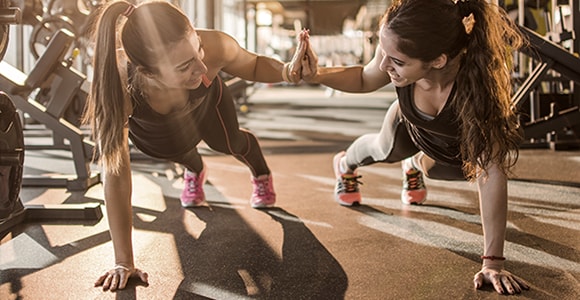Why mixing up exercise is good for you
Trying a new workout could help you stick to your fitness goals.
Lucy E Cousins
March 2018
Finding a workout you like and creating a fitness routine that you’ll stick to can be a challenge. And then once you find it, what happens when the workout you used to find hard becomes easy or boring?
According to personal trainer Tegan Haining, the more you do one kind of exercise, the less strenuous it becomes for your muscles.
“Whenever you start a new workout, you can find it difficult, but once your muscles adapt to the challenge, your body can plateau if you don’t change the movements,” advises Haining.
A study from the University of Florida backs this up; finding that variety in your fitness regimen is essential to help you stick to your health goals. And it’s not just about motivation, East Tennessee State University showed that people who perform a variety of exercises have great fitness gains overall.
We asked Haining for her advice on creating a fitness regimen that will keep your body guessing.

What happens if you don’t mix up your exercise routine?
“Your fitness progress might slow down and any weight loss can creep back on. Changing up the exercise you do keeps your body moving in new ways. This not only helps to keep your metabolism firing, but it can also keep you feeling inspired and motivated.”
How often should we try new exercises?
“This is really down to the individual, but instead of having to come up with a new exercise plan each week, it’s better to create the perfect weekly mix of exercises that will keep your body learning. I always tell my clients to make sure you do a little of what you enjoy and a little of what you need, when planning a week of fitness activities.”
How can I incorporate this fitness approach?
“This might mean lifting weights at the gym, as it boosts your lean muscle mass and then scheduling in 2 yoga-style classes. Stretching and strengthening is a great combination for a toned and balanced body.
Another way is by trying HIIT (high-intensity interval training), which mixes bursts of exercises with short periods of recovery. Studies have shown it’s a highly effective way to lose weight and get fit.
If that’s not for you, start incorporating some walking into your week. It can be integrated safely into most fitness routines, doesn’t cost any money and you can get your friends on board too.”
What’s your advice for people who choose to run for fitness?
“If you prefer to run, it’s always a great idea to add in extra challenges, such as some stairs, running outside, along the coast or in a hilly park. This helps to strengthen different muscles.”
In your opinion, what’s the perfect mix of workouts for a healthy body?
“[For my very fit clients] I like to recommend 2 strength training sessions (60 minutes each) – which means lifting weights in the gym, or bodyweights if you don’t have that option. Then 2 cardio interval sessions of no more than 20 minutes each, plus 1–2 stretch sessions. Keeping your body guessing is the best way to keep seeing results.”
What’s your advice for someone who’s lost motivation for exercise?
“Set yourself a short-term goal. Often when the destination is too far away we put off even starting. A short-term goal will help motivate you; it could be to get up 2 mornings a week for a walk or try a new exercise. Once you’re on track with your short-term goal, you’re more likely to keep going with your long-term fitness routine.”
Related articles
THE IMPORTANCE OF FITNESS IN YOUR 40S
If you’re in (or edging close to) your 40s take note; building exercise into your life can boost your health, now and in the future.
WHICH CARDIO IS RIGHT FOR YOU: STEADY STATE OR HIIT?
Longer sessions at a moderate pace or less time but much more intensity? We compare the differences between these cardio workouts.
IS IT HARDER TO LOSE WEIGHT WHEN YOU’RE OLDER?
With a few lifestyle changes, maintaining a healthy weight doesn’t have to be hard as you age, says dietitian and exercise physiologist Caitlin Reid.